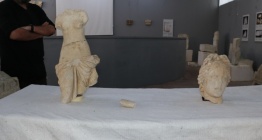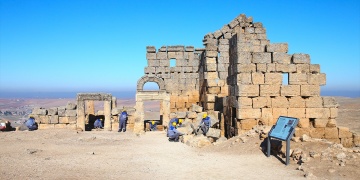interesting asseveration: The stones of the Diyarbakır City Walls was dismantled and sold. Architect Arif Ipek warned that if the measures are not taken, the size of the destruction will increase.
According to the report of Lezgin Akdeniz from Mesopotamia Agency; UNESCO World Cultural Heritage List of the historic walls of Diyarbakir city walls are sold and dismantled. The destruction is especially observed in Mardinkapı. Walls and bastions were embroidered and the stones of the sun, star symbols, tiger, bull, double-headed eagle, scorpion and horse reliefs have been removed.
With its length of 6 kilometers, Walls of Diyarbakir, is the second largest city walls in the world after the Great Wall of China. It is situated 100 m. above the valley of River Tigris. Diyarbakir still carries a medieval atmosphere with its walls encircling the city with its almost intact and impressive, 10-12 meters high and 3-5 meters thick, high walls.
Although there were Roman and probably earlier wallshere, the present walls, date back to early Byzantine times. It welcomes the visitors with relievos and figures on it by telling about the civilizations that lived neighbor on the walls throughout history. There are four main gates along the wall into the old city called as Dag Kapi, Urfa Kapi, Mardin Kapi and Yeni Kapi, each of which deserves a visit along with their inscriptions and reliefs. It also includes 82 watch-towers, which were built in antiquity, approximate 3,000 years ago, restored and extended by the Roman emperor Constantius II in 349.
The Citadel and the Walls of Diyarbakir which is currently on the UNESCO's Tentative List of World Heritage Sites, and Diyarbakir's nutritional source since the city was established thousands of years ago Hevsel Gardens, with its seven hundred-hectare fields, will be worldwide known after they are added to the UNESCO's permanent list.








 Bir Sapiens kafilesi Avrupa'ya buz çağında ulaştı, soğuğa direndi ama soyunu sürdüremedi
Bir Sapiens kafilesi Avrupa'ya buz çağında ulaştı, soğuğa direndi ama soyunu sürdüremedi  Prof. Dr. Aytaç Coşkun: Zerzevan Kalesi'nin altında bir yeraltı kenti var
Prof. Dr. Aytaç Coşkun: Zerzevan Kalesi'nin altında bir yeraltı kenti var  Arkeologlar 4 Bin yıl önce salyangozların ne amaçla toplandığını çözmeye çalışıyor
Arkeologlar 4 Bin yıl önce salyangozların ne amaçla toplandığını çözmeye çalışıyor  Binbeşyüz yıl önce Balıkesir'de batan tabak yüklü geminin batığı bulundu
Binbeşyüz yıl önce Balıkesir'de batan tabak yüklü geminin batığı bulundu 




